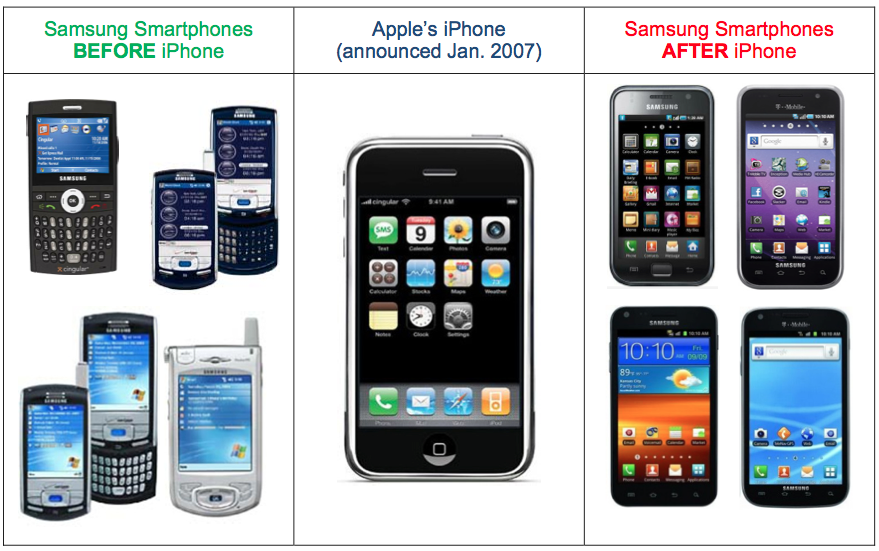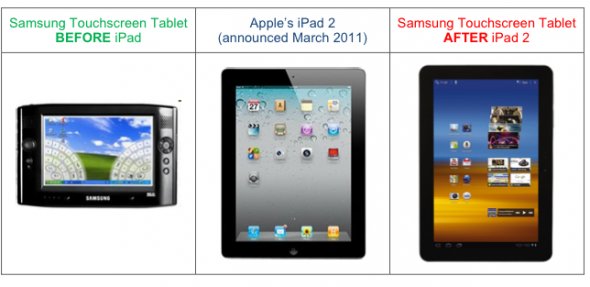Apple vs Samsung Reminds Us: What’s Obvious Today Was Obscure in the Past
‘The man who follows the crowd will usually get no further than the crowd. The man who walks alone is likely to find himself in places no one has ever been before.
“Creativity in living is not without its attendant difficulties, for peculiarity breeds contempt. And the unfortunate thing about being ahead of your time is that when people finally realize you were right, they’ll say it was obvious all along.” Alan Ashley-Pitt as quoted in “The Wonderful Crisis of Middle Age” by Eda LeShan
And so we find on Page 46 of 109 in the Apple-Samsung jury instructions this rather concerning issue: “Obviousness”. Specifically:
“A utility patent claim is invalid if the claimed invention would have been obvious to a person of ordinary skill in the field at the time of invention”
Now I’m no expert in the specifics of this trial. But this fundamental idea concerns me. Because there’s a strange relationship between what’s obvious today and what would have been obvious before a product was released.

Copying Apple makes it far easier to introduce new phones and give them the appearance of “exciting”.
With Innovation, What Was Obscure Often Becomes “Obvious”. Insights and their resulting design choices must be articulated (verbally, visually or in product design) before they become innovations. And true innovation comes from discovering, then executing from, some powerfully unique insight. It also involves sorting through the thousands (millions?) of options that might derive from acting on that insight.
But then, quite often once innovation becomes entrenched in a product or advertisement it’s nearly impossible to ponder any other way it could have turned out.

Once more, Samsung avoids marketing cost and increases product introduction velocity leveraging Apple’s well defined visual language.
Monday Morning Quarterbacks. It’s disconcerting that when my team goes and does all the hard work to reveal those insights and drive an innovation, there are far too many Monday morning quarterbacks who respond merely: your answer is “obvious”.
Riiiiiight. It wasn’t obvious in the beginning or they would have done it.
But here’s the real irony: If your innovation is really powerful and perceptive, people who see the finished result will feel that the solution is “obvious”. And, in the contrary, if your innovation is overtly too complex, it’s probably not that great.
So Can a Jury Travel Back in Time to Envision The Obscurity of Something at a Previous Point in Time? I think this is the nearly impossible reality. In our market research we don’t show storyboards except in very rare circumstances. We don’t show early product drawings unless we have to.
Why? Because the average human being (the jury of our peers, so to speak) lacks the training and experience to project from that early work to know what something final might be.
Have you recently tried to imagine a time before cellular phones? Or before the telegraph? Or imagine physics before the Theory of Relativity (some fairly obvious theory…now)? You simply can’t do that with full truth.
So can a jury project themselves back in time and understand all this? It’s incredibly hard. It’s also the lawyer’s jobs on both sides to attempt to create that picture. Unfortunately, the job of Samsung’s lawyers (“of course it was obvious”) is far easier than the challenge Apple lawyers face (“come with me as I weave a story about time before the smartphone…”).
Update: Apparently Apple’s lawyers presented well. The jury has found for Apple in 6 of 7 claims.
Samsung has Received the Usual Benefit from Being Second to Market. Companies who are second to market are quite often far more successful than those who are first to market.
Microsoft is one superb example. They didn’t create word processing. But Microsoft was able to learn important lessons from the early innovators then create what has become THE word processor most people use.
I worked with a company who was similar in the fitness equipment market. They were miserable at creating their own dramatically new products. But they excelled at looking at what someone else had invented, then making it for far less and making it hit market expectations at that lower price. They made bucket loads of money this way.
What Were Samsung’s Advantages by Following Apple?
They were able to be far faster to market because Apple had answered the key questions and Samsung engineers could move forward on the shoulders of those (Apple) who had gone before.
They achieved success with fewer marketing dollars – because they used shapes that say “like the iPad”. That eliminates the cost of explaining what they have and creates a degree of instant trust that it delivers. (And, they got away with delivering dramatically substandard devices, but leaving the implication that it was an iPad.)
Apple did all the hard work of telling people what a smartphone was. They created the entire reason to exist for the tablet. Samsung merely had to say “yeah – like them, but cheaper”. (It’s worth noting that this is ALL the Droid advertising has ever done.)
How Will the Ruling Go? This is tremendously complex and I wouldn’t presume to suggest I know what, legally, the right answer is. Nor do I know what a jury would do.
But I know what I hope. I hope Apple has enough on their side that the ruling is favorable to Apple. And I hope that companies begin to be given far more useful ways to protect what’s really important.
Yes, I know the patent world is pretty screwed up. And, patent trolls are a horrid group that are, in reality, destroying the last vestiges of meaning for patents in technology.
But it’s self-evident that Samsung copied Apple and made bucket loads of money as a result. Was that legal? Who knows. But we should demand fairness in our society. And no matter the legal specifics or jury findings, it doesn’t seem to me to have been fair.
Update: The jury has found that Samsung violated Apple’s rights and has awarded damages exceeding $1B.
Copyright 2012 – Doug Garnett – All Rights Reserved
Categories: Big Data and Technology, Communication, Consumer research, Digital/On-line, Human Tech, Innovation, Marketing Research, Research & Attribution, Retail
Sorry, comments are closed for this item.
